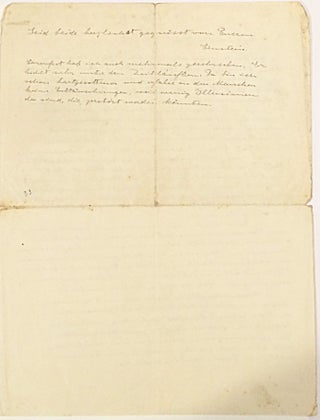Autograph Letter Signed
“the world does not learn from history..."
"people do not disappoint me because there are few illusions which could be destroyed..."
IMPORTANT LETTER ON SCIENCE, POLITICS, AND HISTORY WRITTEN AT A CRITICAL MOMENT IN EINSTEIN'S LIFE.
Written to Dr. Wander Johannes De Haas, with whom Einstein had developed the "Einstein-De Haas Effect" theory of orbiting electrons, the letter, dated May 7, 1933, reads in full (translated from the original German):
Le Coq near Ostend, 7.V.33
My dear De Haas!
I enjoyed your letter very much. Unfortunately, I cannot assume any more obligations, because I already have too much on my shoulders. I have to give a lecture in Brussels until May 20, and then I must travel immediately to Oxford. The position in Germany is terrible and there is no foreseeable change [in sight]. I have heard from reliable sources that war materials are being produced with extreme speed. If one gives these shady characters one or two years' time, Europe will experience some terrible events, events that could be prevented through energetic economical actions. Unfortunately, the world does not learn from history. In France the situation is appropriately judged, however in England they are completely paralyzed because of economical difficulties. Poor Mac Donald!
I am obliged to go to Princeton for the winter months, thereafter to Spain, and God knows when [I must go] to France. In normal times I would not have accepted so many [speaking] obligations, but under today's circumstances rejections may be interpreted incorrectly. Today everything is infiltrated with politics and no one is allowed to ask how one's nerves are going to endure it.
Scientifically Mayer and I have found one very natural generalization of Dirac's equation (formula) which makes it comprehensible, that there are two understandable elementary masses, while there is only one electric mass. I will tell you more about this [topic] when I return to Leyden.
Greetings to both of you,
Yours, Einstein
I also have written a couple of times to Ehrenfest. He is very much under the stress of our times. I am more hard-boiled and people do not disappoint me because there are few illusions which could be destroyed.
Einstein was visiting the United States when Hitler took control of Germany in January of 1933 and was aware of the danger to him. After hearing a report that the Nazis had broken into his house in Caputh, he determined not to return to Germany. Wanting to return to Europe, he did so in March, settling in Le Coq-sur Mare, Belgium. Einstein renounced his German citizenship and resigned from the Prussian Academy of Science, the prestigious organization that had drawn him to Berlin two decades earlier, and was subsequently expelled from the Bavarian Academy, severing completely his German connections. Germany seized his bank accounts in April and his staff joined him in exile in Belgium. In late April, Einstein was invited to teach at the Hebrew University in Jerusalem and make his home in Palestine. On May 10th, the famous Nazi book burning would take place, with Einstein's works foremost of those consigned to the flames. Amidst the swirl of these life-changing and world-changing events, Einstein wrote two important letters on May 7, 1933. One was to Chaim Weizmann rejecting the offer at Hebrew University (he had decided instead to go to the United States); the other was this handwritten, signed letter to his close collaborator Dr. Wander Johannes De Haas.
On the scientific content of the letter:
The pioneering work of Niels Bohr in quantum theory at the Institute for Theoretical Physics in Copenhagen was well known, and the revolutionary new concept of quantum mechanics was being expounded by Heisenberg, Schrödinger, and English physicist Paul Dirac. Dirac deduced the existence of anti-matter in 1930 by linking the special theory of relativity to quantum mechanics. Einstein was an early critic of quantum mechanics and worked to find an alternative unified theory to explain the riddles posed by quantum problems. Walther Mayer was an assistant who travelled with Einstein and in 1932 they published a paper examining Dirac's work and its usefulness in developing a unified theory. This letter indicates that they made additional discoveries on this subject in 1933 and wanted to tell De Haas in Leyden about them. That they communicated their new work to De Haas is shown by the fact that it was published later in 1933 by the Amsterdam Academy (Albrecht Folsing's biography Albert Einstein confirms, "These reflections were continued amidst the dunes of Le Coq and published by the Amsterdam Academy").
Italy's Enrico Fermi, who went on to split the atom under the football stadium at the University of Chicago and pave the way for nuclear physics and the atomic bomb, studied with Paul Ehrenfest at Leiden in the Netherlands. Ehrenfest was Einstein's friend and a physicist who was deeply depressed about political events in Europe. Einstein's observation about him suffering badly and his apparent concern about Ehrenfest were more than justified. Four months after this letter, Ehrenfest committed suicide.
This Letter shows Einstein the scientist, humanitarian and historical visionary, who exhibits a deep understanding of people; it is signed simply as "Einstein" - a letter to a dear friend. It is on wove paper, signed "Einstein", dated May 7, 1933. Document measures approximately 8 1/2 x 11 inches and is handwritten by Einstein on two sides of one sheet of paper with signature on second page.
Check Availability:
P: 212.326.8907
E: michael@manhattanrarebooks.com


